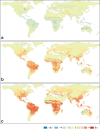Accelerating invasion potential of disease vector Aedes aegypti under climate change
- PMID: 32358588
- PMCID: PMC7195482
- DOI: 10.1038/s41467-020-16010-4
Accelerating invasion potential of disease vector Aedes aegypti under climate change
Abstract
Vector-borne diseases remain a major contributor to the global burden of disease, while climate change is expected to exacerbate their risk. Characterising vector development rate and its spatio-temporal variation under climate change is central to assessing the changing basis of human disease risk. We develop a mechanistic phenology model and apply it to Aedes aegypti, an invasive mosquito vector for arboviruses (e.g. dengue, zika and yellow fever). The model predicts the number of life-cycle completions (LCC) for a given location per unit time based on empirically derived biophysical responses to environmental conditions. Results suggest that the world became ~1.5% more suitable per decade for the development of Ae. aegypti during 1950-2000, while this trend is predicted to accelerate to 3.2-4.4% per decade by 2050. Invasion fronts in North America and China are projected to accelerate from ~2 to 6 km/yr by 2050. An increase in peak LCC combined with extended periods suitable for mosquito development is simulated to accelerate the vector's global invasion potential.
Conflict of interest statement
The authors declare no competing interests.
Figures





References
-
- Messina, J. P. et al. The many projected futures of dengue. Nat. Rev. Microbiol.10.1038/nrmicro3430 (2015). - PubMed
Publication types
MeSH terms
Grants and funding
LinkOut - more resources
Full Text Sources
Medical

